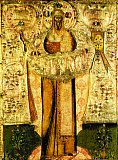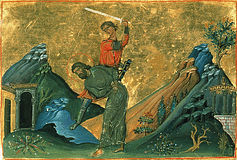

| Previous day | Next day |
| Old Style
March 11
|
Saturday |
New Style
March 24
|
|
5th Week of Great Lent. Laudation of the Most Holy Theotokos. The Akathist of the Most Holy Theotokos.
Tone 8.
Great Lent. |
Wine and oil allowed.
|
![]() St. Sophronius, patriarch of Jerusalem (638-644).
St. Sophronius, patriarch of Jerusalem (638-644). ![]() St. Euthymius, archbishop of Novgorod (1458).
St. Euthymius, archbishop of Novgorod (1458).
Hieromartyr Pionius, priest, of Smyrna, and those with him: Asclepiades, Macedonia, Linus, and Sabina (250). St. Sophronius, recluse of the Kiev Caves (13th c.). St. Sophronius, bishop of Vratsa (Bulgaria) (1813). Translation to Constantinople of the relics of Martyr Epimachus of Pelusium. St. Alexis of Goloseyevsky Skete, Kiev Caves (1917).
New Hiero-confessors Patrick (Petrov), hieromonk of Valaam Monastery (1933) and Michael (Galushko), schema-archimandrite, of Svyatogorsk Monastery (1961).
St. Oengus (Angus) the Culdee, bishop, of Clonenagh (Ireland) (824). Hieromartyr Eulogius, metropolitan of Cordoba (859). St. George the New, wonderworker of Constantinople (ca. 970). St. Theodora, queen of Arta, wife of Despot Michael II of Epirus (ca. 1275). Hieromartyrs Trophimus and Thalus, priests, of Laodicea (300).
Slaying of Emperor Paul I of Russia (1801).
Thoughts for Each Day of the Year
According to the Daily Church Readings from the Word of God
By St. Theophan the Recluse

Saturday. [Heb. 9: 24–28; Mark 8: 27–31]
The Lord asked the apostles how they see Him? In the person of the holy Apostle Peter, they answered Thou art the Christ. This confession did not ripen suddenly, but once it ripened, it settled in the depths of the heart and became the source of his guidance. It was overshadowed by the death of the Lord, but not shaken, and being resurrected in even greater power by the resurrection, it directed the apostles for their entire lives to preach to the whole world. There is a moment for each believer, when he utters with all his strength, “Thou art the Christ, my Lord and Saviour. Thou art my salvation, my light, my strength, my comfort, my hope and eternal life.” Then is accomplished that by which this believer cries with the Apostle: “Who shall separate me from the love of Christ!” (cf. Rom. 8:35) and like him he begins to pursue all that is pleasing to Christ the Lord until he comes unto the measure of His stature (cf. Eph. 4:13).
Articles
 Martyr Macedonia of SmyrnaSaint Macedonia was martyred during the persecution in the reign of Decius (249-251), along with Saints Pionius and Limnus, Sabina, and Asclepiades. |
 Martyr Limnus of SmyrnaSaint Limnus was martyred during the persecution in the reign of Decius (249-251), along with Saints Pionius and Macedonia, Sabina, and Asclepiades. |
 Venerable Sophronius the Recluse of the Kiev CavesSaint Sophronius the Hermit of the Caves was an ascetic of the Far Caves (the Theodosiev Caves), during the thirteenth century. |
 Translation of the relics of the Martyr Epimachus of PelusiumThe Holy Martyr Epimachus of Alexandria was a native of Egypt. |





